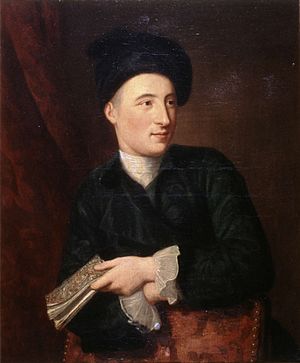Matthew Maty facts for kids
Matthew Maty (born May 17, 1718 – died July 2, 1776) was a Dutch doctor and writer. He came from a Huguenot family, who were French Protestants. After moving to England, he became a key person at the Royal Society and the second main librarian of the British Museum.
Contents
Early Life and Education
Matthew Maty was born in Montfoort, near Utrecht, in the Netherlands. His father, Paul Maty, was a Protestant who had to leave his home in France. Paul settled in the Netherlands and became a minister. However, he faced some disagreements about his religious ideas and had to move several times.
Matthew began studying at Leiden University in 1732. This was a very famous university at the time. In 1740, he earned two degrees. One was a PhD, where he wrote about the idea of 'Custom'. He also earned a medical degree (M.D.) at the same university.
Life and Work in England
In 1741, Matthew Maty moved to London, England, to work as a doctor. He joined a club with other doctors and scientists. Soon, he started focusing more on writing and publishing.
The Journal Britannique
In 1750, Maty began publishing a magazine called the Journal Britannique. This magazine came out every two months and was printed in the Hague. It was written in French and reviewed important new books from England. The Journal became very popular. It was read widely in the Netherlands, France, and other parts of Europe. This magazine helped Maty meet many important writers and thinkers.
Roles at the Royal Society and British Museum
Matthew Maty became a Fellow of the Royal Society in 1751. The Royal Society is a famous group that promotes science. In 1753, when the British Museum was created, he was chosen as an under-librarian. This meant he helped manage the museum's collections.
He was known by famous people like Edward Gibbon, a well-known historian. Maty also had some disagreements, for example, with the famous writer Samuel Johnson. Maty was a strong supporter of inoculation, which was an early way to protect people from diseases like smallpox. He even experimented on himself to show it worked!
In 1762, Maty became the foreign secretary of the Royal Society. Later, in 1765, he was made the main secretary of the Royal Society. In 1772, he became the principal librarian of the British Museum. This was a very important job, as he was in charge of all the museum's books and artifacts. He bought many valuable books for the museum before he died on July 2, 1776.
Key Writings
Matthew Maty wrote several important works:
- Ode sur la Rebellion en Écosse (1746): A poem about the rebellion in Scotland.
- Essai sur le Caractère du Grand Medecin, ou Eloge Critique de Mr. Herman Boerhaave (1747): An essay praising a famous doctor named Herman Boerhaave.
- Authentic Memoirs of the Life of Richard Mead, M.D. (1755): A biography of another important doctor, Richard Mead.
He also contributed to the Philosophical Transactions, which is the scientific journal of the Royal Society. Maty helped finish a book called Life of John Ward for Thomas Birch. He also translated French works about inoculation into English.
Before he died, Maty was working on the Memoirs of the Earl of Chesterfield. This book was finished by his son-in-law, Justamond, and published in 1777.
Family Life
Matthew Maty was married twice. His first wife was Elizabeth Boisragon. They had a son named Paul Henry Maty and three daughters. One of his daughters, Elizabeth, married John Obadiah Justamond, who was a surgeon and translator. Maty's second wife was Mary Deners.



